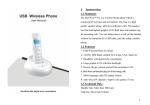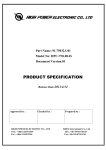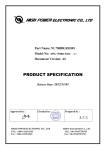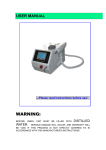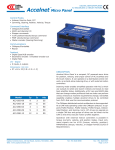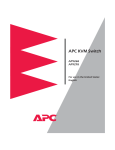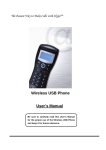Download Micon T20 User`s guide
Transcript
MICON USB VoIP Switch User’s Guide T20/T30 DISCLAIMER MICON T20/T30 USB VOIP/PSTN SWITCH AND THE ACCOMPANIED SOFTWARE AND THE THIRD PARTY VOIP SERVICES ARE NOT INTENDED AS A SUBSTITUTE FOR YOUR PSTN PHONE SERVICE. THEY ARE PROVIDED FOR YOU TO BETTER EXPERIENCE VOIP CALLS OVER THE INTERNET AND DO NOT AND ARE NOT INTENDED TO SUPPORT OR CARRY EMERGENCY CALLS TO ANY TYPE OF HOSPITALS, LAW ENFORCEMENT AGENCIES, MEDICAL CARE UNIT OR ANY OTHER TYPE OF EMERGENCY SERVICES OF ANY KIND OVER THE INTERNET AND THAT MICON , ITS AFFILIATES, PARENT COMPANIES, SUBSIDIARIES, OFFICERS, DIRECTORS, EMPLOYEES, AGENTS AND NETWORKS SERVICE PROVIDERS ARE NOT NOR SHALL BE LIABLE IN ANY MANNER FOR SUCH CALLS. CAUTION DO NOT UNPLUG THE USB CABLE WITHOUT STOPPING MICON SOFTWARE. DO NOT EXIT MICON SOFTWARE OTHERWISE THE PHONE WILL NOT RING ON VOIP CALLS. DO NOT EXPOSE MICON SWITCHES TO DIRECT SUNLIGHT OR DAMP OR HOT ENVIRONMENTS. MICON IS NOT ASSOCIATED IN ANYWAY WITH SKYPETM 1. Introduction 1.1 Features • Receive and make VoIP and PSTN (landline) calls on regular telephones • Forward VoIP calls to any PSTN or mobile phones • Support both corded and cordless phones • DSP Noise cancellation technology • Direct dial VoIP calls • Terminating VoIP calls through phone’s keypad • Compatible with Network PBX • Powered by USB, no external power supply needed 1.2 Technical Specifications • USB port:1 • RJ11 port: 2 • LED: 3 (Power, In, OUT) • Size: 138 x 45 x 25 MM • Working temperature: 0- 60oC • Working voltage: 5V • power: 0.5W (sleeping),1.5W (working) • Operating System: Windows’ 2000•XP 1.3 System Requirement • PIII 450 and above • 128MB RAM • 20MB available storage space • CDROM • USB 1.1 or 2.0 port • Internet Service • Local phone service 1.4 Layout Fig A. Front View Fig B. Back View 2. Hardware Installation 2.1 PSTN connection Unplug your telephone cord from the wall jack. Using the supplied telephone wire, connect one end to the “LINE” port of MICON T20/30, another to the wall jack as shown in Fig.1 Note: 1. PSTN service is required for VoIP call forwarding feature to function properly. 2. The MICON T20/30 has to be installed as the first device on your incoming telephone line if you would like to utilize all household phones for making and receiving VoIP calls. Fig.1 PSTN Connection 2.2 Phone Connection Connect the telephone cord that was just disconnected from the wall jack to the “TEL” port on the MICON T20/30 as shown in Fig.2 Fig.2 Phone Connection 2.3 USB Connection Plug the MICON T20/30 to the USB port on your PC with the included USB cable as shown in Fig.3. The PC will load the necessary driver automatically*. The T20/30 is connected properly. LED will be on once MICON Fig.3 USB Connection Note: *Once installed, MICON T20/30 will be the default sound card for your PC. All sound will be directed to the MICON T20/30 including Microsoft Media Player and any other MP3 players such as iTunes. To use the PC’s built-in sound card, you will need to adjust the audio property in the specific program, or stop the MICON T20/30 program and unplug the USB cable to the MICON T20/30 . CAUTION: DO NOT UNPLUG THE USB CABLE WITHOUT STOPPING MICON SOFTWARE FIRST. 3. Software Installation 3.1 SkypeTM Installation Although MICON T20/30 is designed to work with any VoIP services, its full function can only be realized in conjunction with SkypeTM , a leading free VoIP service provider on the internet. For your convenience, a FREE copy of the SkypeTM software is included on the utility CD*. Please place the utility CD in the CDROM drive and follow the on screen instruction to install Skype**. 3.2 MICON VoIP Utility Installation Double click on the button “Driver for MICON T20/30” to launch MICON VoIP Utility installation program. Follow the on screen instruction to finish the installation. Once successfully installed, you can launch the SKYPAL software by clicking on the icon on the desktop or through the “Start” button on the toolbar as shown in Fig.4. Skype will ask your permission to allow SKYPAL to launch. Select “Allow this program to use Skype” and click “OK”. Fig.4 Launch MICON T20/30 VoIP Software Note: *Please check www.skype.com for latest updates. **Registration is required to receive free SkypeTM service. ***MICON VoIP Utility software is actually a Windows Service which runs in the background. Once launched, there will be only an icon on the system tray at the bottom of the display. 4. How to Make, Receive, and Forward Calls Before you can make, receive, and forward any SkypeTM calls please make sure the SkypeTM client software and SKYPAL utility have been launched and you are logged in successfully. The icon on the system tray indicates that the Internet connection is OK, and the system is ready for calls. The icon means the Internet connection is down or there is a problem during the SkypeTM login process. Please check your internet connection before proceeding to the next section. 4.1 Use MICON T20/30 to make a PSTN call MICON T20/30 is programmed to use PSTN line by default if a PSTN line is connected. So you can use your phone that is connected with MICON T20/30 to call a PSTN number or mobile phone number as you would on any regular phone. 4.2 Use MICON T20/30 to make a SkypeTM call Before you can use your phone to make a SkypeTM call, you will first need to add some contacts to your SkypeTM contact list. Next you will need to assign speed-dial numbers to your contacts, as following• 1. Right click a contact and then select "Assign speed-dial" as shown in Fig.5. Fig.5 Assign Speed-dial number 2. Enter the speed-dial number* and click OK to save setting**. Note: * The speed-dial number ranges from 00 to 99. ** Special service numbers such as international access codes are prohibited to be set into the speed-dial number. * 3. Pick up the handset of the phone connected with MICON T20/30, press " " on the keypad of the phone, and the speed-dial number set in the previous step, then "#". The call will begin to connect (Fig.6). Fig.6 Skype Calls * Note: If MICON T20/30 is not connected with a PSTN line there is no need to dial “ ” first. You can directly dial the speed-dial number plus # (e.g. 22#). 4.3 How to receive calls When somebody calls your SkypeTM or PSTN number, the phone connected to the MICON T20/30 will ring. Pick up the handset or press the hands-free button on your phone to receive the incoming call as you would with a regular phone call. Hang up the phone or press the hands-free again to end the call. 4.4 How to forward incoming Skype calls to your mobile phone One of the key features of MICON T20/30 is its ability to forward incoming SkypeTM calls to your mobile or landline phone automatically. Right click the phone icon on the system tray as shown in Fig.7, then Left click “INPUT PSTN FORWARDING NUMBER” Fig.7 MICON VoIP Utility Setup Menu to save the settings Enter your mobile phone number or other PSTN number, then click (Fig.8). You must enter the complete phone number, including 1+ area code if you are calling a number outside of your area code. Fig.8 Input Forwarding Number again, then Left click “Enable Skype-PSTN Forwarding” to enable Right click the phone icon the function. Now your incoming SkypeTM call will be automatically forwarded. Fig.9 Enable Call Forwarding In some cases, the phone connected to your MICON T20/30 will ring one time before the forwarding process begins. It is important not to pick up the phone connected to your MICON T20/30. Otherwise, the call will not be forwarded. To avoid the SkypeTM call from being accidentally picked up, you can disable the sound notification in the SkypeTM software, as shown below in Fig. 10a and 10b. MICON T-30 VoIP Switch Skype-PSTN Forwarding (“Skype-Out”) Input PSTN Forwarding Number √ Enable Skype-PSTN Forwarding (7342613828) MICON T-30 VoIP Switch Skype-PSTN Forwarding (“Skype-Out”) Input PSTN Forwarding Number Enable Skype-PSTN Forwarding (7342613828) PSTN-Skype Forwarding (“Skype-In”) Enable PSTN-Skype Forwarding (free dial) Input Skype-Forwarding Speed Dial Number Enable PSTN-Skype Forwarding (24) Select a location Testing About Exit Fig.10a Disable Call Notification Fig.10b Disable Call Notification Note: If the MICON T20/30 is connected with PBX as an extension, you will need to use a special dialing format as following: xP123456790 where the first “x” is the code to access an outside line, “P” is a special symbol representing a pause of 2 seconds, and “1234567890” represents the area code and forwarding telephone number (Fig.11). Fig.11 PBX Call Forwarding Setting 4.5 How to Make Skype calls from your mobile phones (MICON T30 Only*) The only difference between the MICON T20 and T30 is that you can make Skype calls from mobile phones or any other PSTN phones (Reverse Forwarding) on the T-30. Following the same process as in the last section you can set up the MICON VoIP utility so that it will automatically forward you call to a specific Skype contact or it will prompt you to enter the speed dial # for the contact you want to call. To make a Skype Call from your mobile phone, all you have to do is to call the PSTN number that is connected to MICON T30 switch, the software will guide you through the rest of the process. Fig.12 Reverse Call Forwarding Setting Note *. The MICON T30 has to be connected with a landline for the reverse call forwarding to function. 4.6 How to mute a call You can place the call on hold by placing the mute button on top of the MICON T20/T30. MICON T-30 VoIP Switch Skype-PSTN Forwarding (“Skype-Out”) Input PSTN Forwarding Number √ Enable Skype-PSTN Forwarding (7342613828) PSTN-Skype Forwarding (“Skype-In”) Enable PSTN-Skype Forwarding (free dial) Input Skype-Forwarding Speed Dial Number √ Enable PSTN-Skype Forwarding (24) Select a location Testing About Exit 5. Appendix: Q&A ► Question 1. After I install MICON T20/30, all speaker outputs, including my favorite MP3 goes to MICON T20/30. How to re-direct all other output to my original sound card? A•Windows installer automatically set MICON T20/30 as the default windows audio device. To correct this issue you can either change the setting in each audio program or reconfigure the default audio setting for Windows as following: “\ Start \ Settings \ Control Panel \ Sounds and Audio Devices \Audio \ Sound playback and Sound Recording” to choose your original sound card as the playback or recording device. If you choose the later route, you will need to configure Skype to use the MICON T20/30 as the sound device by click on “Tools\Options\Sound Devices” ► Question 2. Do I need to connect an outside PSTN line to the “Line” port to use MICON T20/30? A : No. It is only optional. However PSTN line is required when you want to use the same phone for both Skype calls and PSTN calls and want to forward your skype calls to your mobile phone or other PSTN phone (T20/T30) or when you want to make Skype calls from your mobile phones (T30 only). ► Question 3. What kind of Cordless phones can be used to connect to MICON T20/30? A•Any kind of cordless phone with standard RJ11 connector can be used. DECT, 46/49, 900 M, and 2.4 G are all applicable. ► Question 4. Does MICON T20/30 work with SkypeOut? How can I do that? A : Yes. Simply press “*” + "00" + "country code" + "phone number" + “#” to call to any phone in the world. Note: SkypeOut is a paid service offered by Skype ► Question 5. Will my regular PSTN line work even if the host PC is powereddown, MICON T20/30 is not running, or the USB port is not connected? A : Yes, MICON T20/30 will switch to PSTN mode automatically when it loses the host PC connection. So, the PSTN line should continue to work as usual. ► Question 6. Can I use MICON T20/30 with MSN Messenger, Yahoo Messenger, AOL Messenger, or NetMeeting, etc? A : Yes, for sure. In essence, MICON T20/30 works as a standard USB audio device, converting a regular phone into a standard PC sound device for speaker output and microphone input, while maintaining all the regular PSTN phone functions. MICON T20/30 supports all other Internet Phone Software for keypad emulation, voice conversation and switching between PSTN mode and Internet Phone mode. However its full function, including incoming phone ring, direct dial and call forwarding can only be exercised with Skype. ► Question 7. Will MICON T20/30 work Skype’s new releases? A : Most likely. Although MICON T20/30 utilizes some special features offered by the current version of Skype, we do not expect Skype to change these features in the near future, since these features distinguish Skype from other competing VoIP services on the market place, Besides, MICON T20/30 can always support Skype as “Generic” Internet Phone audio device. So, your investment in MICON T20/30 is protected. ► Question 8. When I use the MICON T20/30, do I have to operate the keyboard or mouse? A : No. Actions of dialing on phone are simulated as the action of keyboard and mouse by MICON T20/30 utility software. So you can use any extension that is connected MICON T20/30 to make internet calls without any operation on keyboard or mouse ► Question 9. How do I use MICON T20/30 with an answering machine? A : We recommend you place the answering machine in front of MICON T20/30 so that it can answer PSTN calls when you are online making Skype calls. ► Question 10. How do I use MICON T20/30 with a 2-line phone? A : MICON T20/30 is designed as a single line device. To use it with a 2-line phone, a special line splitter is need to feed line 1 to the input of the MICON T20/30 and line 2 to the phone directly. Please refer to owner’s manual of your specific phone for detail instruction. ► Question 11. Do I have to install MICON T20/30 as the first device on the incoming line? A : You don’t have to. But if you want to use all your phones in the house to make and receive Skype calls, then you will need to. ► Question 12.How do I un-install MICON T20/30? A : Click “\ Start \ Programs \ Skypal \Uninstall Skypal” to un-install MICON T20/30. ► Question 13. What happens if I receive simultaneous calls ? 1.When a PSTN call is being made, the SkypeTM caller will hear a busy tone. 2.When a Skype call is being made, the PSTN caller will hear the ringing tone but no answer. 3.When a call is being forwarded, both SkypeTM and PSTN callers will hear a busy tone. ► Question 14. Why does the MICON T30 continue to dial my Skype contact or stay on-line even after I hang up my cell phone? A : Because the MICON T30 did not receive a busy tone, which is called for by international standard when a call is terminated. The MICON T30 will eventually hang up (around 60 sec) when an off-hook tone is received. If you telephone company does not send a busy tone after a call is terminated you may want to remind the Skype contact to terminate the call first before you hang up.















